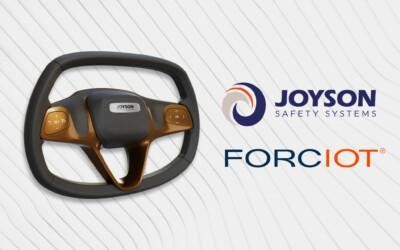Minimalistic and seamless smart surfaces make the car interiors safe and intuitive for the driver, enhancing the in-vehicle experience. Throughout history, seats are designed to keep the driver and passengers comfortable and safe, but as autonomous driving is becoming the future and less intervention is needed from the driver, the expectations for the in-cabin experience increase.
Increasing functionality without added complexity
FORCIOT® sensor technology enables freedom of design for intelligent seating solutions with force, touch, pressure, and gesture sensors for personalization, comfort, and ergonomics in shared and connected cars, self-driving cars, and EVs. Touch and gesture sensing on seat surfaces open new ways of seat control and interaction such as seat adjustments, heating, massage, and ventilation functionalities. For example, on the headrest, each passenger can have:
- Personal volume control.
- Automatic adjustments on different personal preferences based on their poses and positions for comfort and ergonomics.
- Detection system monitoring the condition of the driver and even passengers, to alert in case of distraction, drowsiness, or medical emergency.
With FORCIOT® unique sensor technology, one printed stretchable sensor sheet can have multiple sensing areas and reprogrammable functionalities, which makes the solution cost-effective from manufacturing, assembly, interface, and electronics perspectives.

Premium driving experience
Car manufacturers can create premium driving experiences with intelligent seating solutions, utilizing the most innovative sensor technologies. For demanding consumers, an outstanding seating experience requires interoperability with seat heating, massage, and ventilation functionalities. Thin and stretchable sensors from printed electronics sheets in this case enable aesthetic and intuitive design, while multiple sensing areas allow personalized automatic adjustments, for example, lumbar support based on the pressure sensing or seat bladders that can be adjusted seamlessly based on changes in real force, depending on the selected driving mode automatically in acceleration.
Sustainable future
Electric Vehicles (EVs) require lighter and more sustainable materials for slim and sleek designs. Visions for lightweight, minimalistic seats set limitations for mechanical buttons and sensors in the area. Luckily, there are thin stretchable electronic solutions that meet the requirements of aesthetic trends. And as automated driving technology advances, it creates more complexity in the car seating design, such as the need for rotating seats to create more options for driver and passenger positions. In the near future, there will be also new requirements for the in-cabin space, and for safety features that can be integrated directly into seats.
Accurate data generated from seat sensors to track driver behaviors
Sensors that are seamlessly integrated into car interiors are part of the driving experience, enabling advanced functionality and extreme safety. Seating is a great source of data to detect driver behaviors and movements.
FORCIOT® printed stretchable electronics deliver data and safety based on capacitive force measurement:
- Occupant Classification System (OCS)
- Seat Belt Reminders (SBR)
- Driver Monitoring System (DMS)
- Diver Presence Monitoring (DPM)
- Child Presence Detection (CPD)
Next-generation seating experience
Multi-purpose, comfort, and autonomous driving are key factors that will drive innovations in the intelligent seating system. With the advantages of stretchable electronics and other emerging technologies, there will be ways to solve existing problems and adapt to new demands from consumers, to deliver the ultimate driving experience for years to come.
——————–
Interested in how stretchable electronics work on the seating system? Click here to learn more.




